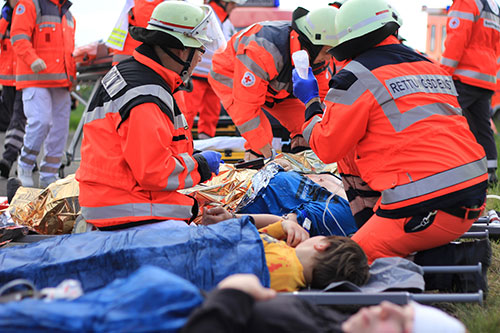In the aftermath of mass-casualty incidents or terrorist attacks, rapid triage – deciding which victims should be treated or transported first based on the severity of their injuries – is vital. Designed and engineered in Germany, the RescueWave® system can help emergency services perform this task effectively and save lives. It is composed of electronic triage devices (Rescue.Nodes) and incident management software (Rescue.Board). These are connected by a customised wireless communication network with automatic data synchronisation and GPS technology which functions independently of other mobile networks.
Effective triage to save lives at mass-casualty incidents developed in Germany
- 29 January 2020
The ERDF funding enabled us to develop a novel solution which contributes to faster treatment in multiple-casualty and other emergency situations. It also enabled us to cope with the technological and business risks. For us as an SME, the funding was therefore crucial to making this important contribution to emergency management.
First responders use Rescue.Nodes to register and track the location of an injured person, turning a dial to attribute a colour-coded priority score. The device, which is left with the victim, displays a coloured electronic tag that is visible at a distance.
Scores and other information are then uploaded onto Rescue.Board, which can be accessed at the scene or remotely via mobile devices and tablets. Incident command units thus have a clear, reliable, real-time overview of the situation, and can take data-driven decisions and organise treatment and transport accordingly.
Orderly rescue operations
Triage typically involves placing coloured paper cards – so-called triage tags – on casualties to indicate the gravity of their wounds. Medical teams check each card to see who needs help most urgently. RescueWave’s Rescue.Nodes – which are waterproof and can withstand extreme temperatures – and its Rescue.Board render these cards and the compilation of paper lists of casualties superfluous. This ensures digital transformation in the crucial domain of public safety.
The idea for RescueWave came to Professor Wilhelm Stork of the Karlsruhe Institute of Technology while watching a documentary about the 1998 Eschede train crash in Germany, in which 101 people died and 88 were seriously injured. He saw the need for a system to ensure that future rescue operations could be carried out in a more orderly manner.
Over a decade of research and development followed before RescueWave was ready for the market. Testing during 13 realistic exercise scenarios involving 500 people was a key part of this process. The tests, within which over 800 hours of data were collected, made it possible to gather feedback from ambulance and rescue workers and optimise the system. This ensured it could be easily integrated into existing incident management procedures.
Digitalisation and automation of incident management workflows
RescueWave provides support across all phases of casualty management. It allows for the recording of all patient data needed for immediate response, and details of initial treatment and transport. Search and rescue information and other personal data can be added and individual casualties allocated to specific hospitals, depending on their needs.
The location and triage category of each patient are visualised on a map, allowing teams to go straight to where they are most needed and giving them an idea of the number of casualties and the extent of the area to be covered. In addition, hospitals and control centres can connect to the network and the system can be adapted to meet the requirements of different teams. Installation and training services are also provided.
RescueWave helps avoid misunderstandings and reduces the need for clarification by radio. As a result, decisions can be made quickly and resources used efficiently so that patients spend as little time as possible at the scene.
In Germany, several counties and the fire brigade of a large city already rely on RescueWave. Being the first digital solution for this domain, the system attracts international attention.
Total investment and EU funding
Total investment for the project “RescueWave” is EUR 562 651, with the EU’s European Regional Development Fund contributing EUR 249 106 through the “Rheinland-Pfalz” Operational Programme for the 2014-2020 programming period. The investment falls under the priority “Research and innovation”.

